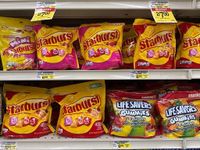The air is crisp, pumpkins are perched on porches, and children everywhere are plotting their candy conquests. But this Halloween, the treats in those plastic pumpkins are looking a little different—and a lot pricier. According to a recent report from CNN, the average price of candy in the United States has surged 10.8% from last year, a jump nearly four times the overall inflation rate. For families and candy lovers alike, that’s a bitter pill to swallow.
What’s behind this sticker shock? The culprit is cocoa, the key ingredient in chocolate, which has seen prices skyrocket to historic highs. As CNN and the Associated Press (AP) both report, cocoa futures soared an astonishing 178% in 2024 after a 61% spike the previous year, all due to poor harvests in Ghana and Ivory Coast. Together, these West African nations supply about 70% of the world’s cocoa. The result: the chocolate lining store shelves this fall was made from some of the most expensive beans on record.
This cocoa crisis has left candy makers scrambling. Hershey’s and Mars, the titans of Halloween candy, have both raised prices and adjusted their packaging to soften the blow. Hershey’s variety packs are up 22%, Mars packs by 12%, and even Reese’s have climbed 8%. Gummies like Sour Patch Kids haven’t been spared either, with prices rising nearly 9%, CNN notes.
But the changes aren’t just in price. Candy companies are quietly giving customers less chocolate per bag or swapping out chocolate for cheaper ingredients. Hershey, for example, told retailers it was tweaking its “price pack architecture”—a fancy way of saying they’re shrinking portions but keeping prices the same, a practice now widely known as shrinkflation. Some boutique brands are also adjusting, lowering cocoa content in chocolate bars from 75% to 65%. As CNN points out, this not only stretches margins but also makes the bars sweeter and less expensive to produce.
Consumers are noticing. According to AP, chocolate made up 52% of the total volume of Halloween candy sold in 2024. But by early October 2025, chocolate’s share had dropped to 44%. Non-chocolate candies—think gummies, sours, and freeze-dried treats—are filling the gap. “Younger buyers are obsessed with sour and chewy candies, and those are cheaper to make,” CNN reported, citing a 7% jump in sour candy sales year over year. KitKat’s new cinnamon-toast flavor and other inventive non-chocolate options are popping up, as candy giants look for creative ways to dodge cocoa costs.
Why are gummies and fruity candies gaining ground? Price is a big factor. In the 12 weeks leading up to October 5, 2025, chocolate Halloween candy cost an average of $8.02 per pound, compared to $5.77 per pound for non-chocolate candy, according to AP. With chocolate prices so high, it’s no wonder trick-or-treaters may find more fruity candy than chocolate in their haul this year.
It’s not just the big brands feeling the squeeze. Independent chocolatiers are struggling to keep up. At Escazú Chocolates in Raleigh, North Carolina, co-owner Tiana Young described the situation as unprecedented. “The tariffs have hit every single every single piece of what goes into every single thing. There is no new normal,” she told CNN. Escazú now pays three to four times the usual price for cacao sourced from small Latin American farms, and increased tariffs have driven up the cost of packaging materials as well. To cope, the shop has cut costs by offering smaller hot chocolates, promoting non-chocolate ice cream toppings, and even relocating to a cheaper space in the city.
Despite the pain, Americans are still spending big on Halloween. The National Confectioners Association told AP that Americans shelled out $7.4 billion on Halloween candy in 2024, representing 18% of all candy sales that year. Mars Inc., one of the largest producers, churns out 30 million M&M’s every day at its Topeka, Kansas facility—enough Snickers bars annually to stretch from Topeka to New York and back seven times. Hershey, meanwhile, held a commanding 40.8% market share of Halloween candy in 2024, with its assortment—including Reese’s, Kit Kat, and Almond Joy—topping sales charts.
But even these candy juggernauts aren’t immune to market pressures. Mars began rolling out Halloween candy to U.S. stores as early as July 5, 2025, a testament to the long planning cycles required in the industry. In fact, Mars takes a full two years to plan for each Halloween season. With so much at stake, every detail matters—from ingredient sourcing to packaging and distribution.
The numbers paint a vivid picture of shifting preferences. Non-chocolate candy dollar sales grew 4.9% in 2024, compared to a mere 0.4% growth for chocolate, according to the National Confectioners Association. On average, Americans buy their Halloween candy 3.6 weeks before the big night, but Generation Z is even more eager, purchasing their treats roughly 4.5 weeks in advance.
There’s another twist: while cocoa prices hit a record $10,710 per metric ton in January 2025, prices have since fallen. But don’t expect relief at the checkout just yet. Dan Sadler, a principal for client insights at market research firm Circana, told AP it will take months for those lower prices to filter down to consumers. In the meantime, high energy and packaging costs continue to keep candy prices elevated. Experts agree: don’t count on candy getting cheaper anytime soon.
For many, Halloween is a time of nostalgia and joy—a chance to indulge in sweet treats and share in a beloved tradition. But this year, the landscape is changing. Shoppers are seeing higher prices, smaller packages, and a wider variety of non-chocolate sweets. For some, it’s a disappointment; for others, an opportunity to try something new. As for the kids? They might not notice the economics at play, but they’ll surely notice the extra gummies in their bags.
For candy makers, retailers, and families alike, this Halloween is a stark reminder that even the sweetest traditions aren’t immune to the forces of global markets. Whether you’re a die-hard chocolate fan or a lover of all things sour and chewy, one thing’s for certain: the candy aisle will never look quite the same.




